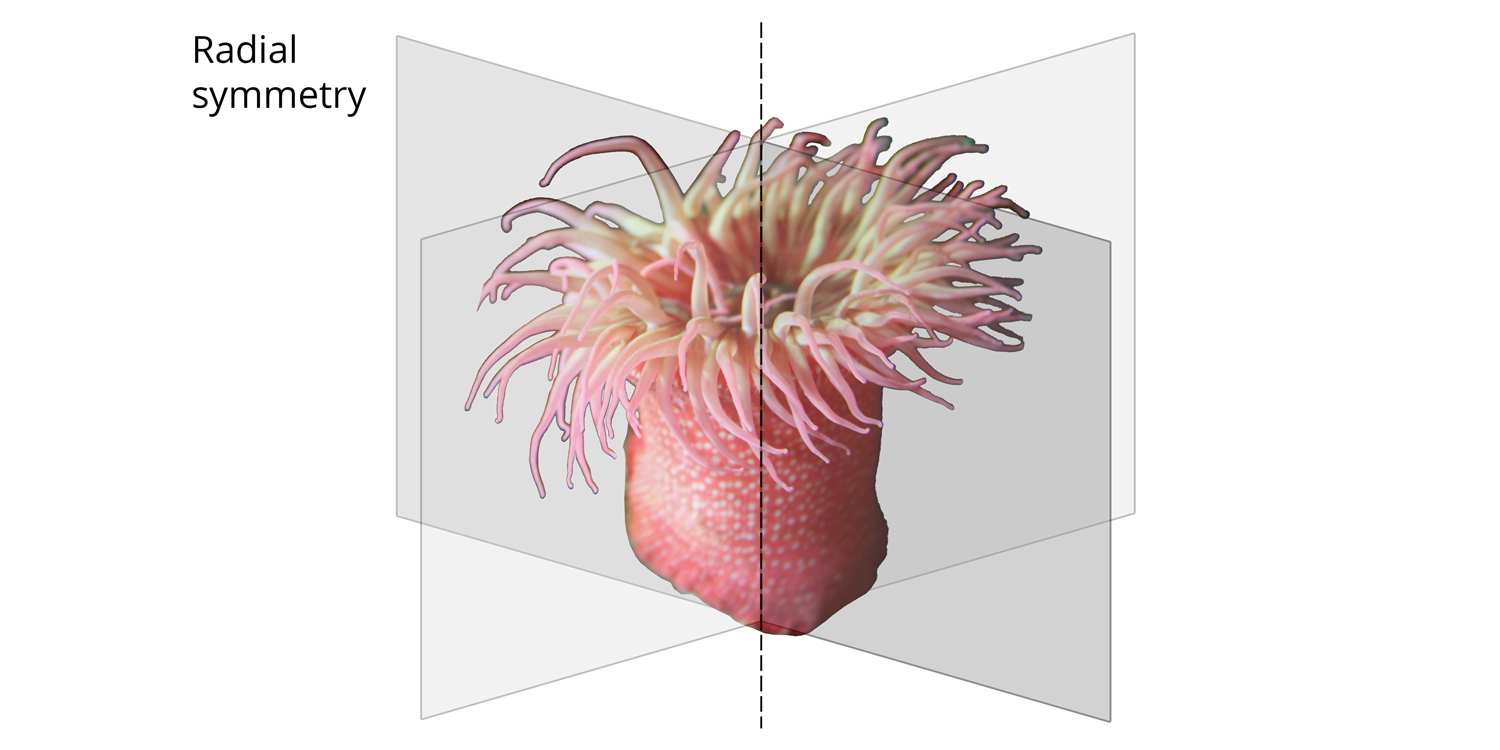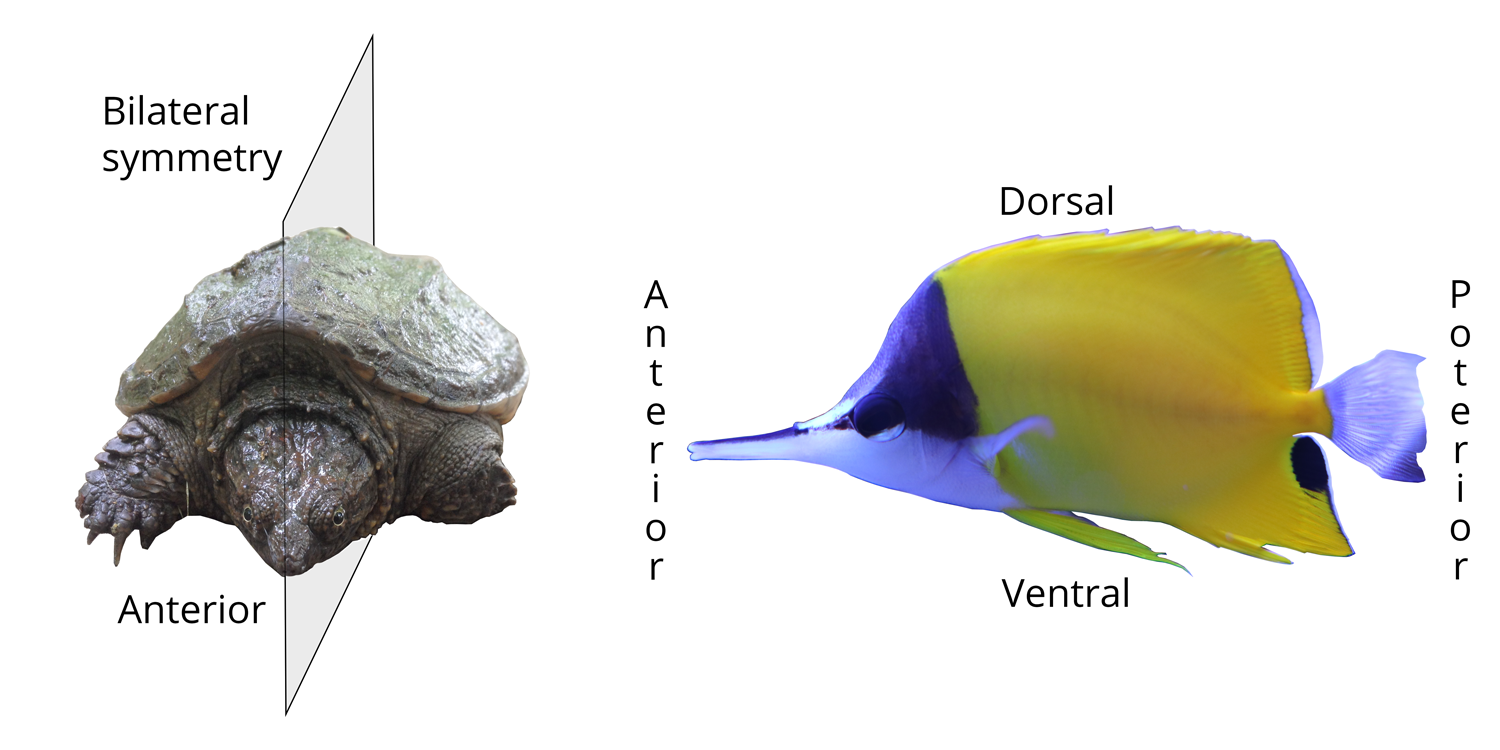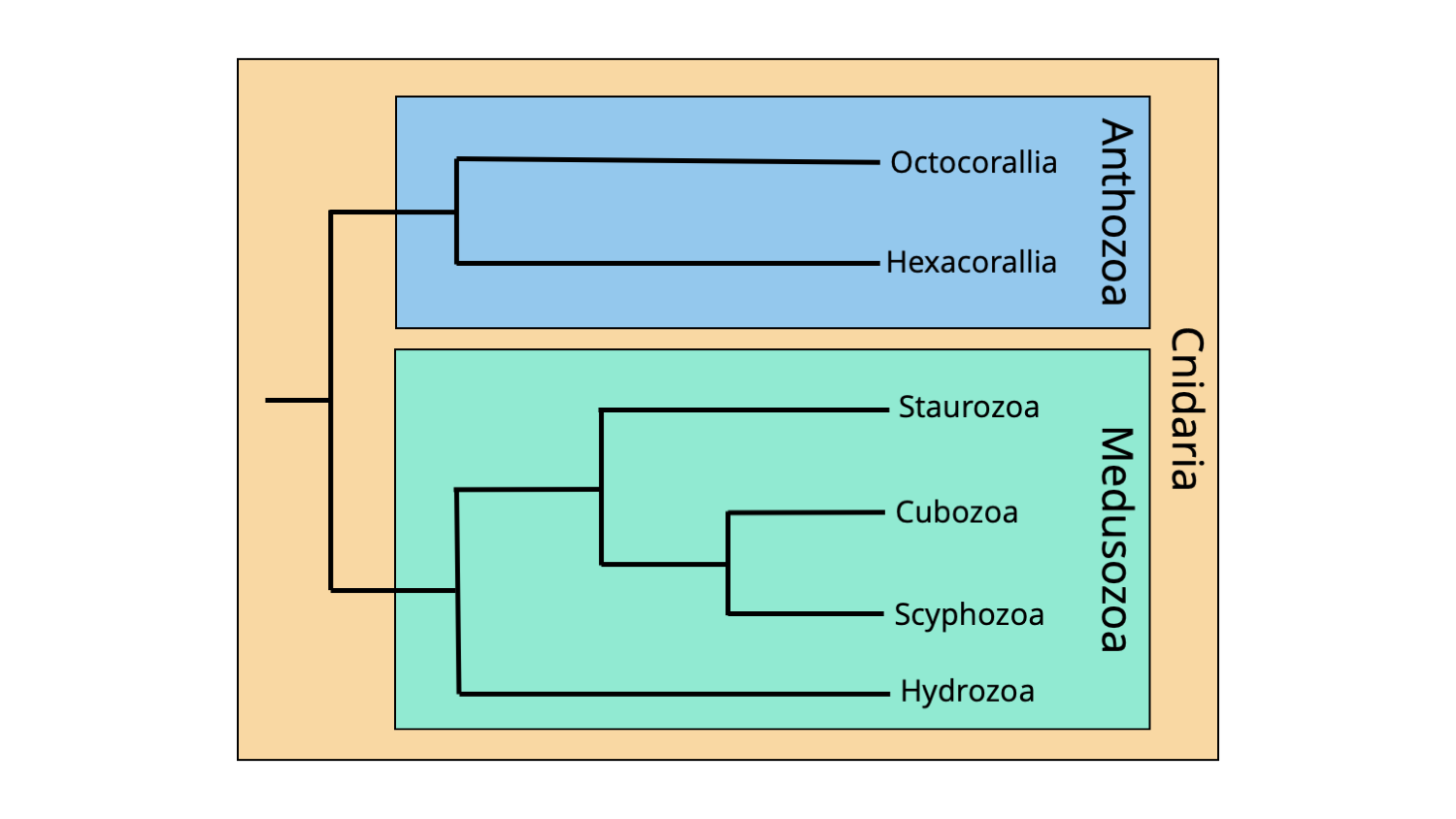Chapter contents:
Cnidaria ←
– 1. Anthozoa
–– 1.1 Scleractinia
–– 1.2 Rugosa
–– 1.3 Tabulata
–– 1.4 Octocorallia
– 2. Hydrozoa
– 3. Cubozoa
– 4. Scyphozoa
Overview
The first thing to know about this phylum of animals is that the "c" that begins "Cnidaria" is silent. Thus, the proper phonetic pronunciation of the group is "ni-daria."
Modern cnidarians exhibit a great diversity of forms, all of which are aquatic and most of which are marine. Cnidaria includes all ancient and modern corals, sea anemones, jellyfish, as well as a variety of less well-known groups.
Features of Cnidarians
Mouths, but no heads or butts
Cnidarians lack heads, so the normal terms that we use to characterize the positions of features on most other animals (e.g., anterior and posterior) do not work well for them (see image further below). They do have mouths (but lack anuses), so terminology of their body forms relates to whether a given feature is oral (mouth side) or aboral (the other side). For example, the tentacles of sea anemones, corals, and jellyfish surround the mouth, so they are on the oral side. Sea anemones attach themselves to rocks on their aboral sides (opposite the mouth); the "bells" of jellyfish represent the aboral side.

The oral and aboral sides of a sea anemone (left) and a jellyfish (right).
Polyps and Medusae
Cnidarians come in two general forms: polyps and medusae. Polyps usually look something like the sea anemone shown in the the photograph above. They have cylinder bodies and are attached by their aboral surface to a hard substrate, with their tentacles and mouth pointing upwards (or, as the photo above shows, sort of sideways). They may be solitary (like a sea anemone) or colonial (like a coral). Medusae look like jellyfish (see photograph above). They are free swimming and bell shaped, with their aboral surface pointing upwards and their mouth and tentacles pointing downwards. Medusae are almost always solitary. Some cnidarian species have both polyp and medusa forms, with each serving a different lifecycle function.
Radial symmetry (sort of)
Another important characteristic of some cnidarians is that they have bodies with nearly radial symmetry. Consider the illustration of the sea anemone below. Imagine cutting it from the top down, like a birthday cake (gross!): no matter how you slice it through the middle, one half is nearly the mirror image of the other.

Illustration of radial body symmetry in a sea anemone. Each plane of symmetry divides the sea anemone into a half that is the mirror image of the other half. All cnidarians have this type of symmetry.
This is not true of most other animal groups (sponges and ctenophores being the exceptions), which have bodies with strong bilateral symmetry (or some version of it). In such bilaterians, there is only one plane of symmetry that will make one side the mirror image of the other (see overview in the Animal Phylogeny chapter).

Left: illustration of bilateral body symmetry in a juvenile snapping turtle. The plane of symmetry makes one side the mirror image of the other. Right: positional terms for bilaterally symmetrical animals. The head end is anterior, the tail end is posterior, the back side is dorsal, and the belly side is ventral.
It is worth noting here, however, that many cnidarian do have body forms that approach bilateral symmetry. Zapata et al. (2015) stated that "it is often asserted that cnidarians are radially symmetrical, but most have bilateral symmetry, some have directional asymmetry, and only a subset of species have radial symmetry." Even so, their headless/buttless bodies all retain a radial aspect of organization that is not observed at all in most bilaterian animals (which have definite anterior and posterior ends). Even though the characterization of cnidarians as radially symmetrical animals and bilaterians as bilaterally symmetrical animals is overly simplistic, these designations are still useful for thinking about the overall organization and structure of the bodies of these animals.
Cnidae and nematocysts
Cnidarians are named for specialized cellular-scale structures that they bear called cnidae. Cnidae perform a variety of functions. Some of these cnidae are called nematocysts, which function much like harpoons and are used to deliver venom, either to capture prey or for defense against enemies. Nematocysts cover the tentacles of cnidarians and are fired when prey or predators brush against a small trigger-like structure called a cnidocil. Nematocysts give jellyfish their sting and are the reason why it is best to avoid contact with them when you are swimming in the ocean.
"How does a jellyfish stick?" by Neosha S. Kashef and TED-ed (Youtube).
Cnidarian phylogeny
Recent molecular phylogenetic work by Zapata et al. (2015) supports the traditional view that the phylum Cnidaria should be divided between two major clades, Anthozoa and Medusozoa.

Phylogenetic relationships of major groups of cnidarians.
Anthozoa is represented by some 7,500 extant species (Zapata et al., 2015) and is divided into two major subgroupings, Octocorallia and Hexacorallia. Octocorallia is represented today by sea pens, gorgonian corals, and soft corals; the group is entirely soft-bodied and consequently has a very poor fossil record. Hexacorallia, however, includes several major groups of extinct and modern corals that produced calcium carbonate skeletons, resulting in a superb fossil record. Soft-bodied sea anemones and several other groups also belong to the Hexacorallia. Most of these groups have polyp-like adult forms.
There are around 3,700 extant species of Medusozoa (Zapata et al., 2015), which is divided into four major groups. The true jellyfish are assigned to the Scyphozoa, while the deadly box jellyfish belong to the Cubozoa. The stalked jellyfish are assigned to the Staurozoa. Finally, Hydra and related forms are assigned to the Hydrozoa. As their name implies, most Medusozoan have medusoid-like (or, jellyfish-like) adult forms, though this is not universally true (e.g., the polyp-like Hydra is an exception).
Most of this chapter focuses on the superb fossil records of members of the Hexacorallia, in particular the extinct rugose and tabulate corals and the extant scleractinian corals. Very brief overviews of the other major groups of cnidarians are also presented, though none have an especially significant fossil record (though some extraordinary fossils are known).
References and further reading
Kozloff, E. N. 1990. Invertebrates. Saunders College Publishing, Philadelphia, 866 pp.
Zapata, F., F. E. Goetz, S. A. Smith, M. Howison, S. Siebert, S. H. Church, S. M. Sanders, C. L. Ames, C. S. McFadden, S. C. France, M. Daly, A. G. Collins, S. H. D. Haddock, C. W. Dunn, and P. Cartwright. 2015. Phylogenomic analyses support traditional relationships within Cnidaria. PLoS ONE 10(10): e0139068.


